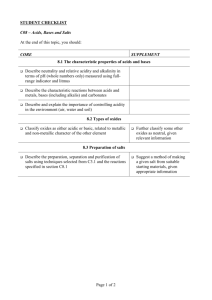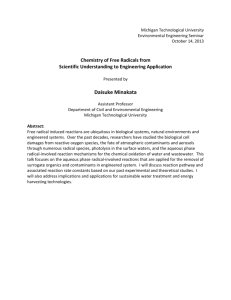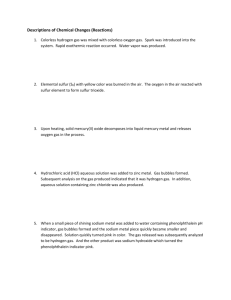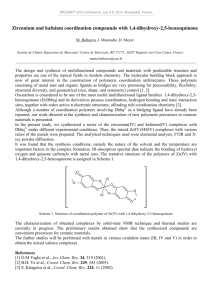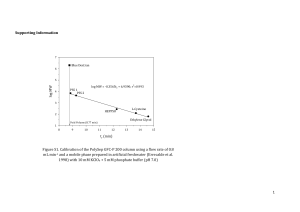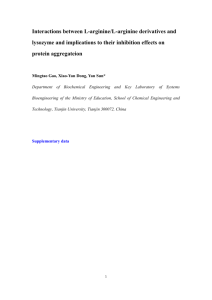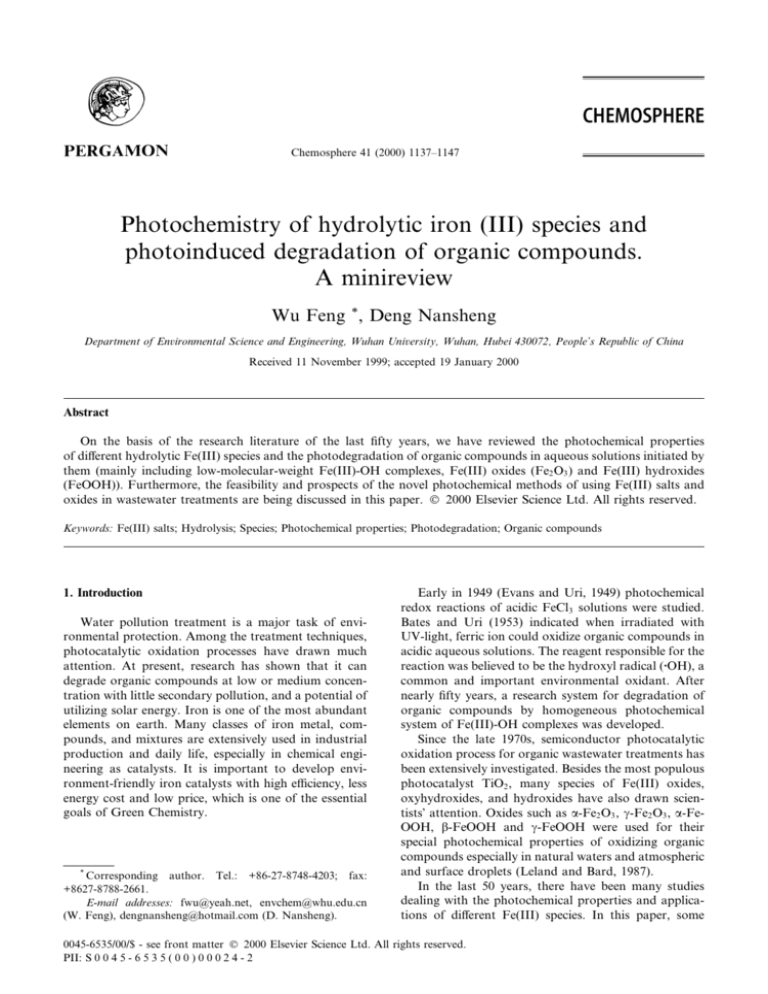
Chemosphere 41 (2000) 1137±1147
Photochemistry of hydrolytic iron (III) species and
photoinduced degradation of organic compounds.
A minireview
Wu Feng *, Deng Nansheng
Department of Environmental Science and Engineering, Wuhan University, Wuhan, Hubei 430072, People's Republic of China
Received 11 November 1999; accepted 19 January 2000
Abstract
On the basis of the research literature of the last ®fty years, we have reviewed the photochemical properties
of dierent hydrolytic Fe(III) species and the photodegradation of organic compounds in aqueous solutions initiated by
them (mainly including low-molecular-weight Fe(III)-OH complexes, Fe(III) oxides (Fe2 O3 ) and Fe(III) hydroxides
(FeOOH)). Furthermore, the feasibility and prospects of the novel photochemical methods of using Fe(III) salts and
oxides in wastewater treatments are being discussed in this paper. Ó 2000 Elsevier Science Ltd. All rights reserved.
Keywords: Fe(III) salts; Hydrolysis; Species; Photochemical properties; Photodegradation; Organic compounds
1. Introduction
Water pollution treatment is a major task of environmental protection. Among the treatment techniques,
photocatalytic oxidation processes have drawn much
attention. At present, research has shown that it can
degrade organic compounds at low or medium concentration with little secondary pollution, and a potential of
utilizing solar energy. Iron is one of the most abundant
elements on earth. Many classes of iron metal, compounds, and mixtures are extensively used in industrial
production and daily life, especially in chemical engineering as catalysts. It is important to develop environment-friendly iron catalysts with high eciency, less
energy cost and low price, which is one of the essential
goals of Green Chemistry.
*
Corresponding author. Tel.: +86-27-8748-4203; fax:
+8627-8788-2661.
E-mail addresses: fwu@yeah.net, envchem@whu.edu.cn
(W. Feng), dengnansheng@hotmail.com (D. Nansheng).
Early in 1949 (Evans and Uri, 1949) photochemical
redox reactions of acidic FeCl3 solutions were studied.
Bates and Uri (1953) indicated when irradiated with
UV-light, ferric ion could oxidize organic compounds in
acidic aqueous solutions. The reagent responsible for the
reaction was believed to be the hydroxyl radical (áOH), a
common and important environmental oxidant. After
nearly ®fty years, a research system for degradation of
organic compounds by homogeneous photochemical
system of Fe(III)-OH complexes was developed.
Since the late 1970s, semiconductor photocatalytic
oxidation process for organic wastewater treatments has
been extensively investigated. Besides the most populous
photocatalyst TiO2 , many species of Fe(III) oxides,
oxyhydroxides, and hydroxides have also drawn scientistsÕ attention. Oxides such as a-Fe2 O3 , c-Fe2 O3 , a-FeOOH, b-FeOOH and c-FeOOH were used for their
special photochemical properties of oxidizing organic
compounds especially in natural waters and atmospheric
and surface droplets (Leland and Bard, 1987).
In the last 50 years, there have been many studies
dealing with the photochemical properties and applications of dierent Fe(III) species. In this paper, some
0045-6535/00/$ - see front matter Ó 2000 Elsevier Science Ltd. All rights reserved.
PII: S 0 0 4 5 - 6 5 3 5 ( 0 0 ) 0 0 0 2 4 - 2
1138
W. Feng, D. Nansheng / Chemosphere 41 (2000) 1137±1147
representative studies in this area are reviewed. The
purpose of this work is not only to present some systematic and useful information on the progress in this
area, but also to underline the importance of this
research and promote its development.
(1975) used tert-butyl alcohol as a scavenger to detect
the photoformation of áOH in the photolysis of
3
4
Fe
H2 O6 and Fe2
OH2 , the reactions are:
áOH HOC
CH3 3 ! H2 O áCH2 C
OH
CH3 2
2
2. Species produced from the hydrolysis in aqueous Fe(III)
solutions
The hydrolysis of Fe(III) salts in aqueous solutions is
a complicated time-dependent process, usually simply
de®ned as hydrolysis-polymerization-precipitation. A
popular mechanism (Flynn, 1984) divided the hydrolysis
process into the following steps: (a) primary hydrolysis
giving rise to low-molecular-weight complexes (monoand dimer); (b) formation and aging of polynuclear
polymers; (c) precipitation of ferric oxides and hydroxides. During these steps, about three classes of products
of dierent species are involved, i.e., low-molecular4
weight complexes (Fe
OH2 ; Fe
OH
2 ; Fe2
OH2 ,
3nÿm
etc.), hydrolytic polymer (Fen
OHm
H2 Ox
, or
Fem On
OH
3mÿ2nÿx
), and precipitated oxides (amorx
phous(am)-Fe(OH)3 , FeOOH, and Fe2 O3 ).
3. Photochemical properties of low-molecular-weight
Fe(III)-hydroxy complexes
In aqueous solutions, low-molecular-weight Fe(III)hydroxy complexes undergo photochemical reduction
to Fe(III) irradiated with UV light (Baxendale and
Magee, 1955; Langford and Carey, 1975), consequently, Fe(III) is reoxidized by oxidants (e.g., dissolved
oxygen) to Fe(III) again. Thus the basic redox circle of
Fe(III)/Fe(II) is completed. In the meantime, hydroxyl
radical (áOH) forms. The general reaction can be
expressed as:
1
Some of the previous investigations were focused
on the quantum yields of Fe(II) and áOH in the
photochemical redox reactions in aqueous solutions
containing Fe(III) ions, and the in¯uence factors
(e.g., irradiation wavelength, pH of the solutions etc.).
Most previous studies (some examples are shown in
Table 1) were carried out in acidic solutions with lM±
mM Fe(III) and 1 mM±0.1 M scavengers for áOH
radicals.
Measurement of quantum yield for áOH radicals by
adding scavengers is an important method to investigate
the photolysis of Fe(III) species. Langford and Carey
Fe3 áCH2 C
OH
CH3 2 H2 O
! Fe2 HOCH2 C
OH
CH3 2 H
3
When 2-propanol was used as the scavenger for áOH,
acetone formed as the oxidized product (Carey and
Langford, 1975; Benkelberg and Warneck, 1995):
áOH
HOCH
CH3 2 ! áC
OH
CH3 2 H2 O
4
áC
OH
CH3 2 Fe3 ! Fe2
CH3 2 CO H
5
More generally, the scavenging reactions for áOH can be
expressed as:
áOH HS ! H2 O áS
Hydrogen extraction
6
Fe
III áS H2 O ! Fe
II HOS H
7
where HS represents scavengers for hydroxyl radicals, áS
activated states or radicals of the scavengers, HOS oxidized products of the scavengers. Dierent results were
gained on áOH quantum yield or Fe(II) quantum yield
when using dierent radical scavengers.
In fact, as we know, in the pH range 6 5 at least four
dierent Fe(III) ions, which are well characterized, coexist in aqueous solution: Fe3 ; Fe
OH2 ; Fe
OH
2
and the dimer Fe2
OH4
2 . The species distribution is
governed by the hydrolysis equilibria shown as reactions
(8)±(10) (Flynn, 1984; Faust and Hoigne, 1990). Fig. 1
displays species distribution of three simple low-molecular-weight Fe(III)-hydroxy complexes.
Fe3 H2 O ! Fe
OH2 H
K1 2:7 10ÿ3 M
8
Fe3 2H2 O ! Fe
OH
2 2H
K2 1:3 10ÿ8 M2
9
Fe3 2H2 O ! Fe2
OH4
2 2H
K3 6 10ÿ4 M
10
W. Feng, D. Nansheng / Chemosphere 41 (2000) 1137±1147
1139
Table 1
Some research results reported on the photochemical properties of Fe(III)-OH complexes
Fe(III) salts solution
Light source
Quantum yield
of áOH
Quantum yield
of Fe2
Reference
Fe3 0 0:01 M
Benzoic acid 2 mM
HClO4 0:02 M
125 W medium pressure
mercury vapor lamp
k 365 nm
)
0.067
Bates and Uri
(1953)
)
)
0.0114
0.113
)
0.286
Fe3 0 0:0346 mM
HClO4 0:010 M
In the absence of benzene
In the presence of benzene
Mercury lamp k 313 nm
Baxendale and
Magee (1955)
Fe3 0 2:07 mM
HClO4 0:010 M
Methyl alcohol 0:07 M
Mercury lamp k 313 nm
Fe
H2 O3
6
Tert-butyl alcohol
Medium pressure mercury
lamp k 253:7 nm
0.065
0.130
Langford and
Carey (1975)
Fe3 0 10:0 lM pH 4:0
Medium pressure mercury
lamp k 313 nm
k 360 nm
0:14 0:04
)
0:017 0:003
)
Faust and
Hoigne (1990)
0.07
)
0.31
)
Tert-butyl alcohol 200 lM
3
Fe 0 0:2 mM
Isopropanol 2 mM
pH 2 3
150 W xenon arc lamp
k 370 nm
k 280 nm
Dierent species have their photochemical properties,
respectively.
3.1. Fe(OH)2
Shown in Fig. 1, Fe(OH)2 is the dominant Fe(III)hydroxy complex in aqueous solution from pH 2:5±5.
Its charge transfer band strongly overlaps the solar UV
Baxendale and
Magee (1955)
Benkelberg and
Warneck (1995)
spectrum (290±400 nm) (Weschler et al., 1986; Faust and
Hoigne, 1990), and it photolyzes eciently to produce
áOH radicals (Baxendale and Magee, 1955; Faust and
Hoigne, 1990):
Fe
OH2 hm ! Fe2 áOH
11
Table 2 shows the comparison of spectra and photochemical properties of low-molecular-weight Fe(III)-OH
complexes. It can be seen that the quantum yield of áOH
produced from the photolysis of Fe(OH)2 is much
higher than that of the other two species Fe
H2 O3
6 and
2
Fe2
OH4
2 . So, in the solution at pH 2.5 to 5, Fe(OH)
is the dominant photoreactive species.
3.2. Fe(H2 O)3
6
It was reported (Langford and Carey, 1975; Benkelberg and Warneck, 1995) that the photochemical reaction of Fe
H2 O3
6 can be expressed as
2
Fe
H2 O3
áOH H
6 hm ! Fe
Fig. 1. Low-molecular-weight species distribution of hydrolytic
Fe(III) salts in aqueous solutions at pH 6 5. (Calculated
according to the hydrolysis equilibria in reaction (8)±(10).)
12
At low pH (<2.5), Fe
H2 O3
is the dominant species
6
(Fig. 1). In spite of its low quantum yield of áOH, it
might be the important contributor for photoformation
of áOH in the system. With increasing pH value, the
contribution of Fe
H2 O3
to the photoformation of
6
áOH decreased. Especially, in the solutions above
pH 3, its contribution can be completely ignored
(Faust and Hoigne, 1990).
1140
W. Feng, D. Nansheng / Chemosphere 41 (2000) 1137±1147
Table 2
4
2
Spectra and photochemical properties of Fe(H2 O)3
6 , Fe(OH) , and Fe2 (OH)2
Species
kmax (nm)
Molar absorption coecient e
(Mÿ1 cmÿ1 )a
Quantum yield of áOH (UOH )
Radiation wavelength
(UOH )
Fe
H2 O3
6
240
4250
Fe(OH)2
297
205
335
2030
4640
5000
k 254 nm
k 6 300 nm
Average value
Max: k 280 nm
k 350 nm
0.065b
0.05c
0.14 0.19d
0.31d
0.007b
Fe2
OH4
2
a
Knight and Sylva (1975).
Langford and Carey (1975).
c
Benkelberg and Warneck (1995).
d
Baxendale and Magee (1955).
b
3.3. Fe2
OH 4
2
The Fe(III) dimer, Fe2
OH4
2 , absorbs strongly in
the solar UV region (290±350 nm) (Knight and Sylva,
1975). It photolyzes to produce free áOH radical. However, because of its small molar-fraction over pH range
<3, its contribution to photoformation of áOH can also
be ignored (Faust and Hoigne, 1990). Besides pH value,
molar-fraction of Fe2
OH4
2 depends also on the total
concentration of Fe(III) species in the solution, so does
its contribution to áOH formation.
3.4. Fe
OH
2
Either the concentration of Fe
OH
2 is too small to
make an impact on the spectrum or its spectrum is indistinguishable from that of Fe(OH)2 , the photohave not been
chemical properties of Fe
OH
2
previously reported (Benkelberg and Warneck, 1995). It
is likely that Fe
OH
2 may also photolyze to produce
áOH radicals, since its precursors, Fe3 and Fe(OH)2 ,
and the further hydrolytic dimerization product,
Fe2
OH4
2 , are all photoreactive. However, this idea
should be tested in the future.
3.5. In¯uences of inorganic anions
Dierent inorganic anionic ligands show dierent
tendencies to form complexes with iron(III) ions (Perrin,
1958; David and David, 1976). In aqueous solutions
containing weak anionic ligands, such as NOÿ
3 and
3
ÿ
ClOÿ
,
the
principal
ion
pair
is
Fe
OH
formed
by
4
hydrolysis ( Rabinowitch and Stockmayer, 1942), while
3
ÿ
in the presence of Clÿ or SO2ÿ
4 , the ion pairs Fe OH
and Fe3 Clÿ or Fe3 SO2ÿ
coexist,
which
has
an
in¯u4
ence on the photoreduction of Fe3 to form áOH radicals and the oxidant capability of the system.
The photoreactivities of the two species, Fe3 Clÿ and
Fe3 SO2ÿ
4 , were both reported by some authors (Uri,
1952; Benkelberg and Warneck, 1995). David and David
(1976) conducted a comparative study on the photoredox chemistry of FeCl3 and Fe(ClO4 )3 in aqueous media, they thought that the primary photoprocess was
the photodissociation of Fe(OH)2 in aqueous solutions
of FeCl3 as well as Fe(ClO4 )3 , and the photodissociation
of Fe3 Clÿ to produce áCl radicals (Fe3 Clÿ hm !
Fe2 áCl) was not supported. Weschler et al. (1986)
indicated that under the typical rain and fog water
conditions, Fe(OH)2 and Fe
SO4 are major ionic
Fe(III) species, and both of their ultraviolet charge
transfer spectra overlap with solar radiation in the 290±
400 nm wavelength region. The associated photochemical process of Fe
SO4 was con®rmed to be
Fe
H2 O5
SO4 hm ! Fe2
H2 O5 SOÿ
4
13
Photodecomposition of the NOÿ
3 ion irradiated by UV
light at the wavelength near 200 and 300 nm has been
studied by many authors since the 1970s. Some authors
(Treinin and Hayon, 1970; Strehlow and Wagner, 1982;
Warneck and Wurzinger, 1988) indicated that the photolysis of NOÿ
3 in aqueous solution resulted in a convenient formation of áOH radicals. So, when irradiated,
3
ÿ
NOÿ
3 coexisting with Fe -OH complexes may have an
in¯uence on the oxidation of organic compounds in
aqueous solutions (Zepp et al., 1987).
In the recent study (Zhou et al., 2000) on photodegradation of dyes in aqueous solutions containing
Fe(III)-hydroxy complexes, Zhou et al., found that the
anion's in¯uence on photodegradation rate of the dyes is
in the order of increasing photoreactivity as follows:
ÿ
ÿ
2ÿ
NOÿ
3 > Cl ClO4 > SO4 .
4. Degradation of organic compounds in aqueous solutions
induced by photolysis of Fe(III)-hydroxy complexes
Early in the 1950s, the photo-oxidation of organic
compounds in aqueous acidic solutions containing
W. Feng, D. Nansheng / Chemosphere 41 (2000) 1137±1147
Fe(III)-hydroxy complexes with UV-light radiation was
investigated (Bates and Uri, 1953; Baxendale and
Magee, 1955). The oxidant was believed to be hydroxyl
radicals produced from the photolysis of Fe(III)-OH
complexes, typically, Fe(OH)2 (reaction (11)). Now, the
basic conclusions have been made as follows: in aqueous
Fe(III) solutions at pH 3 5, Fe(OH)2 is the dominant
species; it photolyzes to produce hydroxyl radicals,
which is an extremely strong (E0 2:80 V) nonselective oxidant that can attack organic compounds and
degrade them.
Besides reaction (11), hydroxyl radicals can also be
formed in several other reactions:
Fe2 O2 ! Fe3 Oÿ
2
14
2Oÿ
2 2H ! H2 O2 O2
15
Fe2 H2 O2 ! Fe3 áOH OHÿ
16
Since the 1990s, with the ¯ourishing of Advanced Oxidation Processes, many researchers have stressed the
photochemical degradation system containing Fe(III)OH complexes. Both man-made UV-light and the natural sunlight have been used in their studies on the
photo-oxidation and degradation of organic compounds
of many classes such as benzene, phenols and its derivatives (Kochay, 1992; Hideki and Atushi, 1993; 1994;
Brand et al., 1998), chloro-organic carboxylates compounds (Maruthamuthu and Huie, 1995), as well as
triazines (Larson et al., 1991). Kinetics, in¯uence factors, and mechanisms of the photodegradation have
been involved in these studies.
For dierent organic compounds, the photodegradation rates are not identical, which re¯ects their photodegrabilities. An important idea should be emphasized
that there must be several steps in the whole reaction of
the photodegradation of organic compounds in aqueous
solutions. At least, one was the photoformation of áOH
radicals; another was áOH radicalsÕ attacking target
groups or bonds in organic compounds, and the latter
might be a rate-controlling step in the photodegradation
system, which mainly caused the dierence of photodegradation rates among organic compounds. That was
why the authors got dierent áOH quantum yields or
Fe(II) quantum yields when using dierent radical
scavengers.
5. Photochemistry of Fe(III) oxides, oxyhydroxides, and
hydroxides
There are many naturally occurring and synthetic
iron oxides. Transformation of one structure to another
is possible by hydration-dehydration and/or partial ox-
1141
idation±reduction (Blesa and Matijevic, 1989). There are
dierences in physical, chemical, photochemical, and
photoelectrochemical properties of Fe(III) oxides (Leland and Bard, 1987). All these properties can be associated with the photocatalytic semiconductors, typically
TiO2 with a band gap of 3.2 eV, and the activity of
photoproducing eÿ ±h couple.
Leland and Bard (1987) studied the photoelectrochemical properties of colloids and particles of dierent
iron oxides. They believed a-Fe2 O3 was the most eective catalyst for the photo-oxidation of sul®te. Frank
and Bard (1977) investigated the photocatalytic oxidation of cyanide and sul®te by several semiconductor
powders. They found that TiO2 rather than a-Fe2 O3 was
an active photocatalyst for cyanide oxidation. Cunningham et al. (1988) presented evidence for the photocatalytic formation of áOH radicals in illuminated
suspensions of a-FeOOH.
Wells et al. (1991) investigated the photolysis of
colloidal iron in the oceans, and found that the photoprocess apparently proceeded through a cycle of photoreductive dissolution/rapid reoxidation/precipitation
involving organic chromophores and yielded amorphous, highly labile Fe(III) precipitation. Fe2 was also
a transient species in oxic seawater of pH 8. From
above, we can primarily see that the mechanism of
photochemical reaction of Fe(III) oxides might dier
from that of photocatalytic semiconductors.
5.1. Fe2 O3
Iron oxide, a possible n-type semiconductor with a
band gap of 2.2 eV, is a potentially interesting semiconductor for interfacial electron transfer (Baumgarter
et al., 1983). Faust and Homann (1986) proposed the
mechanism of photoinduced reductive dissolution of aFe2 O3 in bisul®te. They interpreted their results in
terms of a photoinduced ligand-to-metal charge
transfer from adsorbed organic reductant to a Fe(III)
center on the metal oxide surface. This idea was accepted by most authors (Stramel and Thomas, 1986;
Cunningham et al., 1988; Litter et al., 1991; Litter and
Blesa, 1992; Goldberg et al., 1993; Pehkonen et al.,
1995; Pulgarin and Kiwi, 1995). Goldberg et al. (1993)
also proposed that, in many cases, the electron transfer
step is rate-limiting, and the rate constant for this step
has been shown to depend on the surface properties of
the metal oxide and the nature of the complexing
ligand.
Kormann and his coworkers (Kormann et al., 1989)
examined the photocatalytic activity of a-Fe2 O3 colloids
and compared them to the colloids and suspensions of
ZnO and TiO2 . The formation of H2 O2 and the oxidation of organic molecules were studied. ZnO and TiO2
were found to be quite active photocatalysts in
1142
W. Feng, D. Nansheng / Chemosphere 41 (2000) 1137±1147
producing hydrogen peroxide and in the degrading
chlorinated hydrocarbon molecules, while only negligible photocatalytic activity was found for a-Fe2 O3 .
Another exploration of photochemical properties of
Fe(III) oxides has focused on utilizing solar energy to
photodecomposition of water to produce hydrogen.
Khader et al. (1987a,b) reported the preparation and
photochemical behavior of an iron oxide catalyst with
much improved activity, which was undoped and produced hydrogen when illuminated with light. In the
presence of N2 , dissociation of H2 O and reduction of N2
to NH3 occurred concomitantly. The reactions are
shown as below:
N2 6H 6eÿ ! 2NH3
17
3H2 O 6h ! 3=2O2 6H
18
These explorations have shown great potential for sunlight-driven production for clean hydrogen energy. But
further work is needed.
5.2. FeOOH
Goldberg et al. (1993) reported the photoreductive
dissolution of colloidal goethite (a-FeOOH) in the
presence of dierent mono-carboxylate and polycarboxylate species. They pointed out that the photoreduction rate depended strongly on the structure of the
adsorbed acid. Their results helped to explain the role of
photolysis in the dissolution of iron from a goethite
lattice when an organic acid was adsorbed as a ligand
complex and radiated with sunlight. Photo-dissolution is
one of the environmental behaviors of goethite and
other iron(III) oxides, which is important for iron cycle
in the environment.
Waite and Morel (1984) proposed a model of photoreductive dissolution of c-FeOOH in natural waters
(see Fig. 2). This model basically presented the photochemical redox cycle of Fe(III)/Fe(II) between solid
phase and aqueous phase, i.e., the photolysis of Fe(III)organic ligand complexes at the colloid surface and the
concomitant release of reduced Fe(II) to solution, which
was subsequently oxidized to Fe(III).
In fact, as we can see, there is no absolutely signi®cant dierence between Fe2 O3 and FeOOH in the
mechanism of photoinduced reductive dissolution.
Additionally, there have been some studies dealing
with other applications of iron(III) hydroxides as
photocatalysts to produce hydrogen or ®x nitrogen,
which are thought to be important for solving some
problems related with energy shortage and nitrogenous
fertilizer production. Tennakone et al. (1987) reported a
simple system for practical photo®xation of N2 to NH3 .
They had found that hydrous iron(III) oxides loaded
Na®on ®lms in aerated water at alkaline pH yields both
ÿ
NH3 and NOÿ
2 =NO3 upon UV irradiation (Tennakone
et al., 1991). The reactions are shown as follows:
N2 6H 6eÿ
conduction band ! 2NH3
19
2H2 O 4h
valence band ! O2 4H
20
N2 4H2 O 6h ! 2NOÿ
2 8H
21
2H2 O N2 O2 2h ! 4H 2NOÿ
2
22
5.3. Amorphous Fe(OH)3
In acidic solutions, amorphous Fe(OH)3 can easily
dissolve to produce Fe3 and Fe(III)-hydroxy complexes,
which undergo further photolysis. That is proposed to
be the predominant mechanism of photoformation of
reduced Fe2 and hydroxyl radicals in the system. The
transition from the solid phase to aqueous phase is faster
in the solution containing am-Fe(OH)3 than other
polymorphous Fe(III) oxides. So, It is believed that
aqueous photochemical reactions play an important
role in reductive dissolution of am-Fe(OH)3 in natural
waters.
6. Photodegradation of organic compounds on the surface
of Fe(III) oxides in aqueous solutions
Fig. 2. Model on photoreductive dissolution of FeOOH in the
system containing organic ligand L where >FeOOH represents
Fe(III) oxides; L organic ligands; L0 oxidized product of L.
Pehkonen et al. (1995) investigated the photooxidation of halogenated acetic acids on the surface of
iron oxides. The fastest rate of photoreduction of
Fe(III) to Fe(II) was achieved with iron oxide as an
electron acceptor and ¯uoroacetic acid as an electron
donor. The relative rates of photo-oxidation of the
monohalogenated acetic acids with iron oxide were in
order: FCH2 CO2 H > ClCH2 CO2 H > BrCH2 CO2 H >
W. Feng, D. Nansheng / Chemosphere 41 (2000) 1137±1147
ICH2 CO2 H; for multiple substituents: FCH2 CO2 H >
F2 CHCO2 H > F3 CCO2 H. With respect to the iron
oxide electron acceptors, the relative order of reactivity
toward monohaloacetetate oxidation was am-Fe2 O3
á3H2 O > c-Fe2 O3 > c-FeOOH P a-Fe2 O3 P Feaerosol >
a-FeOOH.
Pulgarin and Kiwi (1995) indicated the photo-oxidation of 2-aminophenol in an aerated iron oxide suspension could be due to three mechanisms, i.e., (i) a
ligand-to-metal charge transfer process as shown in
Fig. 2; (ii) photoproduction of eÿ ±h couple, the holes
are scavenged by 2-aminophenol and the electrons by
the surface iron(III) ion, and (iii) the OH radicals
resulting from the oxidation of surface OH groups (reaction (23)).
> FeAOH hm ! Fe2 áOH
23
But, after comparison of photo-oxidation of phenol,
nitrophenol, and chlorophenol, Pulgarin and Kiwi
(1995) suggested that the photocatalytic degradation of
2-aminophenol was more related to a surface complex in
mechanism (i) other than to a semiconductor-assisted
photodegradation in mechanism (ii).
Although till now, no one has con®rmed that Fe(III)
oxides or oxyhydroxides are high ecient photocatalysts, most of the researchers believe that, with a narrow
band gap, Fe(III) oxides would show better photoelectrochemical response at longer wavelengths in the
visible region than TiO2 . They have the potential of
utilizing solar energy, perhaps in wastewater treatment
in the future.
Studies on photodegradation of organic compounds
on the surface of Fe(III) oxides included the degradation
reaction kinetics, in¯uence factors, and mechanisms. It
has been found that the reaction kinetics of the degradation of adsorbed organic compounds was generally in
accordance with the Langmuir±Hinshelwood (L±H)
equation (Fox and Dulay, 1993)
1 1
1
r k
k KáC
where r represents photodegradation rate of the substrate, k the rate constant of pseudo-®rst-order reaction,
K the adsorption constant, C the concentration of the
substrate.
7. Hydrolytic polymers and their photochemical properties
Polymeric products of hydrolyzed ferric salts are the
mediate products between primary hydrolysis products
of low-molecular-weight and precipitated products. In
spite of their complicated structures and large quantity
of species, they are thought to be photoreactive since
their precursor and advanced hydrolytic products are all
1143
photochemical reactive species. This idea is about to be
con®rmed.
8. Fe(III)-organic ligand complexes and their photochemical properties
The photo-oxidation of carboxylic acids has long
been known to be sensitized by Fe(III), but only till
1960s has attention been paid to what coordination
species might be involved (Balzani and Carassiti, 1970).
The carboxylate group [RC(O)Oÿ ] is one of the most
common functional groups of the dissolved organic
compounds present in natural waters (Thurman, 1985;
Perdue and Gjessing, 1990). Polycarboxylates (e.g.,
oxalate, malonate, and citrate) form strong complexes
with Fe3 that undergo rapid photochemical reactions
in sunlight (Zuo and Hoigne, 1992; Faust and Zepp,
1993).
Since the 1950s, numerous investigations have found
that Fe(III)-oxalato complexes photolyze with high ef®ciency (Parker, 1954; Parker and Hatchard, 1959;
Cooper and DeGra, 1971; 1972; Miles and Brezonik,
1981). Zuo and Hoigne (1992; 1994) have shown that the
photolysis of Fe(III)-oxalato complexes is a major
pathway for the formation of H2 O2 in atmospheric
waters. The possible photochemical reactions in the
Fe(III)-oxalato-oxygen system are shown as (Zuo and
Hoigne, 1992):
Fe
OX
3ÿ2n
hm ! Fe
OX
4ÿ2n
OXÿ á
n
nÿ1
24
OXÿ á O2 ! Oÿ
2 á 2CO2
25
Oÿ
2 áH ! HO2 á
26
HO2 á=Oÿ
2 á Fe
III H ! Fe
II O2
27
HO2 á=Oÿ
2 á Fe
II H ! Fe
III H2 O2
28
If the C2 O2ÿ
4 á radicals react with Fe(II), additional
Fe(III) formed; however, if they react with O2 , then a
sequence of oxidants (áOÿ
2 =HO2 á; H2 O2 , and áOH) is
formed (Faust and Zepp, 1993). Zuo and Hoigne (1992)
detected the H2 O2 formation in the solutions containing
10 lM Fe(III) and 120 lM oxalate at pH 4, they found
the observed rate of formation of H2 O2 in September
noon sunlight was 80 nMsÿ1 . The formation rate of
H2 O2 is related to pH, irradiation intensity and the
concentrations of oxalate and dissolved iron. The
H2 O2 formed in the Fe(III)-oxalato system can react
with Fe2 according to a Fenton mechanism (Zepp et al.,
1992)
1144
W. Feng, D. Nansheng / Chemosphere 41 (2000) 1137±1147
Fe2 H2 O2 ! Fe3 áOH HOÿ
29
Zuo and Hoigne (1992) indicated that the production of
áOH radicals in atmospheric water droplets has considerable signi®cance as they can oxidize a wide variety
of natural and anthropogenic organic and inorganic
substances.
Since the 1910s, some studies have shown that the
photochemical dissociation of Fe(III) citrate complexes
in aqueous solutions involved reduction of Fe(III) to
Fe(II) and concomitant oxidation of the carboxylic
acid, resulting in the formation of acetone and carbon
dioxide as the ®nal products (Frahn, 1958; Buchanan,
1970). The general reaction can simply be represented
as
C
OH
COOH
CH2 COOH2 2Fe3 hm
! CH3 COCH3 2Fe2 3CO2 2H
30
where the coordination structure was not given. The
eciency of the photoreduction reaction in aqueous
solutions depends much on two factors: the pH and the
initial citrate to metal ratio (Abrahamson et al., 1994). It
is thought that Fe(III)-citrate complex can photolyze to
produce hydrogen peroxide and hydroxyl radicals
through the similar pathway as that of Fe(III)-oxalato
complex (Deng et al., 1998a).
Additionally, members from EAWAG at ETH (Institute for Water Resources and Water Pollution
Control at Swiss Federal Institute of Technology), especially W. Stumm, J. Hoigne, L. Sigg, Y. Zuo, and
their co-workers R.G. Zepp, B.C. Faust etc., have done
outstanding work on photochemical redox cycle of
Fe(III)/Fe(II) in natural waters and their chemical and
ecological eects (Behra and Sigg, 1990; Zuo, 1992;
Zuo and Hoigne, 1993). This research indicated the
importance of dissolved organic compounds and iron
ions involved in the photochemical formation of hydrogen peroxide and other photooxidants in natural
surface waters.
9. Application of dierent Fe(III) species to photochemical
process of wastewater containing organic compounds
The photocatalytic oxidation method, one of the
Advanced Oxidation Processes, is based on utilizing
hydroxyl radicals formed in the system. Since 1993,
Deng and Wu et al. (Deng et al., 1996, 1997a,b, 1998a;
Luo et al., 1999; Wu et al., 1999) have paid much attention to applying Fe(III) salts and oxides as photosenstator or photocatalysts to promote the degradation
and decolorization of dyes in aqueous solutions both
under UV-light and sunlight. The results have shown
that photodegradation rates of dyes were not identical
when using dierent Fe(III) species. Among those
Fe(III) complexes used, Fe(III)-organic ligand complexes (Ferric-oxalato (Deng et al., 1997a) and Ferric
citrate (Deng et al., 1998b)) are more ecient than
Fe(III)-hydroxy complexes (Deng et al., 1996, 1997b) in
accelerating the photodegradation of the dyes, especially
under sunlight (Wu et al., 1999).
At present, there has been no report about the
practical use of Fe(III) oxides in photochemical process
for wastewater treatment. The feasibility of this application needs to be shown. In the photodegradation of
dyes, some forms of Fe(III) oxides were used as catalysts (Deng et al., 1998a), amorphous Fe(OH)3 presented most photochemically reactive, probably for its
dissolution to produce Fe(III)-OH complexes in acidic
solutions. Additionally, multi-techniques combination
for wastewater treatment is a practicable routine for
industrial wastewater of high pollutant concentration.
In a preliminary investigation, Wu et al. (1998) designed a ¯occulation-photo-oxidation combination to
treat the dye Reactive Red 2 solution at a concentration of 300 mg/l. A decolorization eciency of 82.5%
was obtained.
This research is basic and simple, and needs to be
improved in many aspects such as developing new
photochemical reactors and catalysts carriers, involving
typical pollutants for treatment, their photodegradation
mechanisms, and so on.
10. Conclusion
Hydrolytic Fe(III) species have their respective
photochemical properties, which shows not only in
absorption spectra, photochemical reaction mechanisms and products, but in their eects on the formation, transfer, transformation, and sinks of
environmental chemicals. The pH, Fe(III) concentration, wavelength and energy of irradiation source, and
the nature of organic compounds coexisting have
strong in¯uence on their photochemical properties. All
the products of low-molecular-weight of hydrolytic iron(III) species can photolyze to produce hydroxyl
radicals, among them Fe(OH)2 is the most photochemically active species. It can be presumed that hydrolytic Fe(III) polymers also have photoactivity.
Fe(III) oxides, oxyhydroxides, and hydroxides photodissolve in aqueous acidic solutions and initiate the
degradation of organic compounds. Their mechanisms
of photochemical reactions are not identical to that of
the semiconductors such as TiO2 .
The photochemical properties of hydrolytic Fe(III)
species can be applied to wastewater treatment either for
its photoformation of hydroxyl radicals, or for the
charge transfer from adsorbed organic compounds to
W. Feng, D. Nansheng / Chemosphere 41 (2000) 1137±1147
the metal. These applications realize the transformation
from fundamental theories of environmental chemistry
to applied technologies for pollution control.
Acknowledgements
This work is ®nanced by Wuhan University Ziqiang
Foundation, P.R. China. Thanks go to the anonymous
reviewers. Many enlightening discussions with Prof.
Tian Shizhong (Department of Environmental Science
and Engineering, Wuhan University, People's Republic
of China) and Dr. Y. Zuo (Department of Chemistry,
University of Massachusetts, Dartmouth, USA) are
gratefully acknowledged.
References
Abrahamson, H.B., Rezvani, A.B., Brushmiller, J.G., 1994.
Photochemical and spectroscopic studies of complexes of
iron(III) with citric acid and other carboxylic acids. Inorganic Chimica Acta 226, 117±127.
Balzani, V., Carassiti, V., 1970. Photochemistry of Coordination Compounds. Academic Press, New York.
Bates, H.G.C., Uri, N., 1953. Oxidation of aromatic compounds in aqueous solution by free radicals produced by
photo-excited electron transfer in iron complexes. J. Am.
Chem. Soc. 75, 2754±2759.
Baumgarter, E., Blesa, M.A., Marinovich, H.A., Maroto,
A.J.G., 1983. Heterogeneous electron transfer as a pathway
in the dissolution of magnetite in oxalic acid solutions.
Inorg. Chem. 22, 2224±2228.
Baxendale, J.H., Magee, J., 1955. The photochemical oxidation
of benzene in aqueous solution by ferric ion. Trans. Faraday
Soc. 51, 205±213.
Behra, P., Sigg, L., 1990. Evidence for redox cycling of iron in
atmospheric water droplets. Nature 344, 419±421.
Benkelberg, H-J., Warneck, P., 1995. Photodecomposition of
iron(III) hydroxo and sulfato complexes in aqueous solution: wavelength dependence of OH and SOÿ
4 quantum
yields. J. Phys. Chem. 99, 5214±5221.
Blesa, M.A., Matijevic, E., 1989. Phase transformation of
iron oxides, oxohydroxides, and hydrous oxides in aqueous solution media. Adv. Colloid Interface Sci. 29,
173±221.
Brand, N., Mailhot, G., Bolte, M., 1998. Degradation photoinduced by Fe(III): method of alkylphenol ethoxylates
removal in water. Environ. Sci. Technol. 32, 2715±2720.
Buchanan, D.N.E., 1970. Mossbauer spectroscopy of radiolytic
and photolytic eects on ferric citrate. J. Inorg. Nucl. Chem.
32, 3531±3533.
Carey, J.H., Langford, C.H., 1975. Outer sphere oxidation of
alcohol and formic acid by charge transfer excited states of
iron(III) species. Can. J. Chem. 53, 2436±2440.
Cooper, G.D., DeGra, B.A., 1971. On the photochemistry of
ferrioxalate system. J. Phys. Chem. 75, 2897±2902.
Cooper, G.D., DeGra, B.A., 1972. The photochemistry of the
monoxalatoiron(III) ion. J. Phys. Chem. 76, 2618±2625.
1145
Cunningham, K.M., Goldberg, M.C., Weiner, E.R., 1988.
Mechanisms for aqueous photolysis of adsorbed benzoate
oxalate and succinate on iron oxyhydroxide (goethite)
surfaces. Environ. Sci. Technol. 22, 1090±1097.
David, F., David, P.G., 1976. Photoredox chemistry of iron(III)
chloride and iron(III) perchlorate in aqueous media. A
comparative study. J. Phys. Chem. 80, 579±583.
Deng, N., Deng, Z., Wu, F., 1998a. Study on photochemical
discoloration of the aqueous dyes solutions containing
Fe(III) oxides of dierent species. Shanghai Environ. Sci.
17, 38±41 (in Chinese).
Deng, N., Fang, T., Tian, S., 1996. Photodegradation of dyes in
aqueous solutions containing Fe(III)-hydroxy complex. I.
Photodegradation kinetics. Chemosphere 33, 547±557.
Deng, N., Wu, F., Luo, F., Liu, Z., 1997a. Photodegradation of
dyes in aqueous solutions containing Fe(III)-oxalato complex. Chemosphere 35, 2697±2706.
Deng, N., Wu, F., Luo, F., Xiao, M., 1998b. Ferric citrateinduced photodegradation of dyes in aqueous solutions.
Chemosphere 36, 3101±3112.
Deng, N., Wu, F., Tian, S., Fang, T., 1997b. Photodegradation
of dyes in aqueous solutions containing Fe(III)-hydroxy
complex. II. Solar photodegradation kinetics. Chemosphere
34, 2725±2735.
Evans, M.G., Uri, N., 1949. Photochemical polymerization in
aqueous solution. Nature 164, 404.
Faust, B.C., Homann, M.R., 1986. Photoinduced reductive
dissolution of a-Fe2 O3 by bisul®te. Environ. Sci. Technol.
20, 943±948.
Faust, B.C., Hoigne, J., 1990. Photolysis of Fe(III)-hydroxy
complexes as source of OH radicals in clouds, fog and rain.
Atmos. Environ. 24A, 79±89.
Faust, B.C., Zepp, R.G., 1993. Photochemistry of aqueous
iron(III)-polycarboxylate complexes: roles in the chemistry
of atmospheric and surface waters. Environ. Sci. Technol.
27, 2517±2522.
Flynn Jr., C.M., 1984. Hydrolysis of inorganic iron(III) salts.
Chem. Rev. 84, 31±41.
Fox, M.A., Dulay, M.T., 1993. Heterogeneous photocatalysis.
Chem. Rev. 93, 341±351.
Frahn, J.L., 1958. The photochemical decomposition of the
citrate-ferric iron complex: a study of the reaction products
by paper ionophoresis. Aust. J. Chem. 11, 399±405.
Frank, S.N., Bard, A.J., 1977. Heterogeneous photocatalytic oxidation of cyanide and sul®te in aqueous
solutions at semiconductor powders. J. Phys. Chem. 81,
1484±1488.
Goldberg, M.C., Cunningham, K.M., Weiner, E.R., 1993.
Aquatic photolysis: photolytic redox reactions between
geothite and adsorbed organic acids in aqueous solutions.
J. Photochem. Photobiol. A: Chem. 73, 105±120.
Hideki, K., Atushi, I., 1993. Photochemical generation rates of
hydroxyl radical in aqueous solutions containing Fe(III)hydroxy complex. Chemosphere 27, 2381±2387.
Hideki, K., Atushi, I., 1994. Kinetics of ferric ion promoted
photodegradation of 2-chlorophenol. Chemosphere 28,
57±62.
Khader, M.M., Lichtin, N.N., Vurens, G.H., Salmeron, M.,
Somorjai, G., 1987a. Photoassisted catalytic dissociation of
H2 O and reduction of N2 to NH3 on partially reduced
Fe2 O3 . Langmuir 3, 303±304.
1146
W. Feng, D. Nansheng / Chemosphere 41 (2000) 1137±1147
Khader, M.M., Vurens, G.H., Kim, I.-K., Salmeron, M.,
Somorjai, G.A., 1987b. Photoassisted catalytic dissociation
of H2 O to produce hydrogen on partially reduced a-Fe2 O3 .
J. Am. Chem. Soc. 109, 3581±3585.
Knight, R.J., Sylva, R.N., 1975. Spectrophotometric investigation of ironIII hydrolysis in light and heavy water at 25°C.
J. Inorg. Nucl. Chem. 37, 779±783.
Kochay, J., 1992. Eects of iron(III) and manganese(II) ions on
the aquatic photodegradation rate of bromoxynil (3,5dibromo-4-hydroxybenzontirile) herbicide. Chemosphere
25, 261±268.
Kormann, C., Bahnemann, D.W., Homann, M.R., 1989.
Environmental photochemistry: is iron oxide (hematite)
an active photocatalyst. A comparative study: a-Fe2 O3 ,
ZnO, TiO2 . J. Photochem. Photobiol. A: Chem. 48,
161±169.
Langford, C.H., Carey, J.H., 1975. The charge transfer
photochemistry of the hexaaquoironIII ion, the chloropentaaquoiron(III) ion, and the l-dihydroxo dimer explored
with tert-butyl alcohol scavenging. Can. J. Chem. 53,
2430±2435.
Larson, R.A., Scchlauch, M.B., Marley, K.A., 1991. Ferric ion
promoted photodecomposition of triazines. J. Agric. Food
Chem. 39, 2057±2063.
Leland, J.K., Bard, A.J., 1987. Photochemistry of colloidal
semiconducting iron oxide polymorphs. J. Phys. Chem. 91,
5076±5083.
Litter, M.I., Baumgartner, E.C., Urrutia, G.A., Blesa, M.,
1991. Photodissolution of iron oxides. 3. Interplay of
photochemical and thermal process in maghemite/carboxylic acid system. Environ. Sci. Technol. 25, 1907±1913.
Litter, M.I., Blesa, M., 1992. Photodissolution of iron oxides.
IV. A comparative study on the photodecomposition of
hematite, magnetite, and maghemite in EDTA media. Can.
J. Chem. 70, 2502±2510.
Luo, F., Deng, N., Wu, F., Xiao, M., 1999. UV-light induced
discoloration of dye solutions in the presence of Fe(III) and
humic acid. Toxicol. Environ. Chem. 71, 125±134.
Maruthamuthu, P., Huie, R.E., 1995. Ferric ion assisted photooxidation of haloacetates. Chemosphere 30, 2199±2207.
Miles, C.J., Brezonik, P.L., 1981. Oxygen consumption in
humic-coloured waters by a photochemical ferrous-ferric
catalytic cycle. Environ. Sci. Technol. 15, 1089±1095.
Parker, C.A., Hatchard, C.G., 1959. Photodecomposition of
complex oxalates. Some preliminary experiments by ¯ash
photolysis. J. Phys. Chem. 63, 22±26.
Parker, C.A., 1954. Induced autoxidation of oxalate in relation
to the photolysis of potassium ferrioxalate. Trans. Faraday
Soc. 50, 1213±1221.
Pehkonen, S.O., Siefert, R.L., Homann, M.R., 1995. Photoreduction of iron oxyhydroxides and the photo-oxidation
of halogenated acetic acids. Environ. Sci. Technol. 29,
1215±1222.
Perdue, E.M., Gjessing, E.T., 1990. Organic Acids in Aquatic
Ecosystems. Wiley, New York.
Perrin, D.D., 1958. The ion Fe(CNS)
2 . Its association constant and absorption spectrum. J. Am. Chem. Soc. 80,
3852±3856.
Pulgarin, C., Kiwi, J., 1995. Iron oxide-mediated degradation,
photodegradation, and biodegradation of aminophenols.
Langmuir 11, 519±526.
Rabinowitch, E., Stockmayer, W.H., 1942. Association of
Ferric ions with chloride, bromide and hydroxyl ions (A
spectroscopic study). J. Am. Chem. Soc. 64, 335±347.
Stramel, R.D., Thomas, J.K., 1986. Photochemistry of iron
oxide colloids. J. Colloid Interface Sci. 110, 121±129.
Strehlow, H., Wagner, I., 1982. Flash photolysis in aqueous
nitrite solutions. Z. Phys. Chem. 132, 151±160.
Tennakone, K., Lleperuma, O.A., Bandara, J.M.S., Thaminimulla, C.T.K., Ketipearachchi, U.S., 1991. Simultaneous
reductive and oxidative photocatalytic nitrogen ®xation in
hydrous iron(III) oxide loaded na®on ®lm in aerated water.
J. Chem. Soc. Chem. Commun., 579±580.
Tennakone, K., Wickramanayake, S., Fernando, C.A.N.,
Lieperuma, O.A., Punchihewa, S., 1987. Photocatalytic
nitrogen reduction using visible light. J. Chem. Soc. Chem.
Commun., 1078±1080.
Thurman, E.M., 1985. Organic Geochemistry of Natural
Waters. Martinus Nijho, Dordrecht.
Treinin, A., Hayon, E., 1970. Absorption spectra and reaction
kinetics of NO2 , N2 O3 and N2 O4 in aqueous solution. J. Am.
Chem. Soc. 92, 5821±5828.
Uri, N., 1952. Inorganic free radicals in solution. Chem. Rev.
50, 413±414.
Waite, T.D., Morel, F.M., 1984. Photoreductive dissolution of
colloidal iron oxides in nature waters. Environ. Sci. Technol. 18, 860±868.
Warneck, P., Wurzinger, C., 1988. Product quantum yields for
the 305 nm photodecomposition of NO-3 in aqueous
solution. J. Phys. Chem. 92, 6278±6283.
Wells, M.L., Mayer, L.M., Donard, O.F.X., Sierra, M.M.,
Ackelson, G., 1991. The photolysis of colloidal iron in the
oceans. Nature 353, 248±250.
Weschler, C.J., Mandich, M.L., Graedel, T.E., 1986. Speciation, photosensitivity, and reactions of transition metal ions
in atmospheric droplets. J. Geophys. Res. D: Atmos. 91,
5189±5204.
Wu, F., Deng, N., Luo, F., 1998. Experimental study on the
treatment of dye wastewater by ¯occulation-photo-oxidation process. Environ. Prot. Chem. Indus. 18, 136±139 in
Chinese.
Wu, F., Deng, N., Zuo, Y., 1999. Discoloration of dye solutions
induced by solar photolysis of ferrioxalate in aqueous
solutions. Chemosphere 39, 2079±2085.
Zepp, R.G., Faust, B.C., Hoigne, J., 1992. Hydroxyl radical
formation in aqueous reactions (pH 3±8) of iron(II) with
hydrogen peroxide: The photo-Fenton reaction. Environ.
Sci. Technol. 26, 313±319.
Zepp, R.G., Hoigne, J., Bader, H., 1987. Nitrate-induced
photo-oxidation of trace organic chemicals in water. Environ. Sci. Technol. 21, 443±450.
Zhou, D., Wu, F., Deng, N. 2000. Photodegradation of dyes
in aqueous solutions containing Fe(III)-hydroxy complexes.
III. Inorganic anionÕs eects. Toxicol. Environ. Chem. (in
press).
Zuo, Y., Hoigne, J., 1992. Formation of hydrogen peroxide and
depletion of oxalic acid in atmospheric water by photolysis
of iron(III)-oxalato complexes. Environ. Sci. Technol. 26,
1014±1022.
Zuo, Y., Hoigne, J., 1993. Evidence for photochemical formation of H2 O2 and oxidation of SO2 in authentic fog water.
Science 260, 71±73.
W. Feng, D. Nansheng / Chemosphere 41 (2000) 1137±1147
Zuo, Y., Hoigne, J., 1994. Photochemical decomposition of
oxalic, glyoxalic and pyruvic acid catalyzed by iron in
atmospheric waters. Atmos. Environ. 38, 1231±1239.
1147
Zuo, Y. 1992. Photochemistry of iron(III)/iron(II) complexes in
atmospheric liquid phases and its environmental signi®cance. Ph.D. Dissertation. ETH, Zurich, No. 9727.


